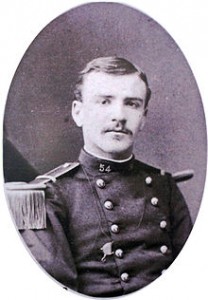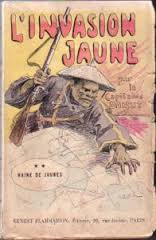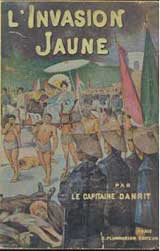Posted: July 28th, 2014 | No Comments »
Eileen Chang’s (Zhang Ailing) Half a Lifelong Romance is now available as a Penguin Modern Classic

From one of twentieth-century China’s greatest writers and the author of Lust, Caution, this is an unforgettable story of a love affair set in 1930s Shanghai.
Manjing is a young worker in a Shanghai factory, where she meets Shujun, the son of wealthy merchants. Despite family complications, they fall in love and begin to dream of a shared life together – until circumstances force them apart. When they are reunited after a separation of many years, can they start their relationship again? Or is it destined to be the romance of only half a lifetime? This affectionate and captivating novel tells the moving story of an enduring love affair, and offers a fascinating window onto Chinese life in the first half of the twentieth century.
Eileen Chang was born in Shanghai in 1920. She studied literature at the University of Hong Kong but returned to Shanghai in 1941 during the Japanese occupation, where she established her reputation as a literary star. She moved to America in 1955 and died in Los Angeles in 1995.
Posted: July 27th, 2014 | No Comments »
A bit of a deviation this but an interesting one I think. I’ve recently blogged about Jonathan Fenby’s e-book The Siege of Tsingtao and my own Betrayal in Paris, both part of the Penguin China World War One Series. One thing a lot of reviewers and readers have asked is about why Germany was in Tsingtao and what was this German Pacific Empire of theirs?
Well, the Germans of course were late comers to colonialism and need to scramble to grab some bits and pieces. German East Africa is perhaps better known and remembered but, from the 1860s, the Germans showed an interest in the the Samoan Islands and the unexplored north-east quarter of New Guinea with adjacent island territories. To be honest they didn’t do much with these places – too remote, inhospitable, plain uninteresting. But they did scramble for China to have a base for the Kriegsmarine in the Far East. Germany’s prewar colonies in the southern Pacific included German New Guinea and Micronesia (later incorporated into German New Guinea), Kaiser- Wilhelmsland, Bismarck Archipelago, Bougainville Island (all of which are now part of Papua New Guinea), Nauru, the Marshall Islands, the Mariana Islands (the present-day Northern Mariana Islands), the Caroline Islands (now the Federated States of Micronesia and Palau) and German Samoa (now Samoa).
Adrian McKinty’s The Sun of God is the true story of August Engelhardt’s cult that lived on the small island of Kabakon in New Guinea. Engelhardt’s cult had everything you’d expect from a German health cult – nudism, sun worship, odd dietary requirements (they termed themselves cocovores, living off coconuts and bananas and suffering malnutrition as a result!). According to Engelhardt – “Naked cocovorism is God’s will. The pure coconut diet makes man immortal and united with God.” So now you know.
However, there was apparently infighting and falling out and some unexplained deaths among the cultists in the early 1900s – hence the subject of McKinty’s book. The Sun of God is a great little trip into a side water of history that really hasn’t been swum in much.

It is 1906 and Will Prior is in self-imposed exile on a remote South Pacific island, working a small, and failing, plantation. He should never have told anyone about his previous existence as a military foot policeman in the Boer War, but a man needs friends, even if they are as stuffy and, well, German, as Hauptmann Kessler, the local government representative.
So it is that Kessler approaches Will one hot afternoon, with a request for his help with a problem on a neighbouring island, inhabited by a reclusive, cultish group of European ‘cocovores’, who believe that sun worship and eating only coconuts will bring them eternal life. Unfortunately, one of their number has died in suspicious circumstances, and Kessler has been tasked with uncovering the real reason for his demise. So along with a ‘lady traveller’, Bessie Pullen-Burry, who is foisted on them by the archipelago’s eccentric owner, they travel to the island of Kabakon, to find out what is really going on.
Posted: July 26th, 2014 | 2 Comments »
In 1929 the American movie stars Douglas Fairbanks and his wife, “America’s Sweetheart”, Mary Pickford visited Shanghai. Having won the first Oscar, Fairbanks was sent on a world tour to promote Hollywood. 5,000 fans flocked to Woosung to welcome the couple’s ship to Shanghai. However, the KMT government was concerned about the content of some of their films (see this post on The Chinese Mirror Chinese cinema blog). This photo shows Fairbanks and Pickford with the staff of the Mingxing Film Studio with Fairbanks standing next to the Shanghai starlet Hu Die (Butterfly Wu).
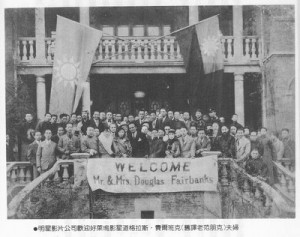

Fairbanks

Pickford
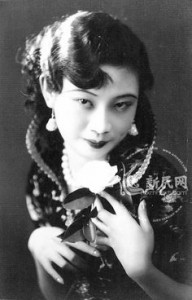 Hu Die
Hu Die
Posted: July 25th, 2014 | No Comments »
An exhibition of photographs of old Limehouse Chinatown, and an interactive map up online too….
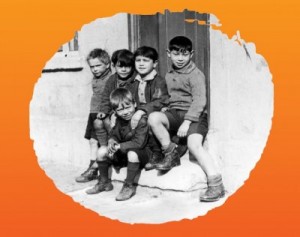
‘The Last Days of Limehouse’ is an exhibition of photos and interactive website and your very own downloadable audio tour to help you discover the fascinating history of Limehouse Chinatown. The exhibition is in the foyer of Limehouse Town Hall. The Limehouse Chinatown Website has an interactive map of the area.
Posted: July 24th, 2014 | 1 Comment »
I’ve blogged repeatedly over the years (since 2008 I just realised) about Beijing’s Chaonei No. 81 (here, here, and here) which has acquired something of a reputation as a haunted house. Of course, unless you are a complete idiot who believes fairies leave money under your pillow when teeth fall out, blokes in red come down chimneys with presents and that there’s an old man with a big beard who lives in the sky, you’ll realise it’s just an old house that has somehow managed to avoid destruction (something of a miracle itself in modern Peking). Interestingly now, thanks to a film “Jingcheng No. 81†or, in English, “The House That Never Dies” apparently (haven’t seen it, don’t know if it’s any good I’m afraid – there’s a trailer here), according to Amy Qin in the New York Times young people are “swarming” to the place.

It is of curse lovely that upwards of 500 people a day are visiting the house, and hopefully they’ll enjoy it, but there seems to be no resolution to what the owners, the Catholic Diocese of Peking, are intending to do with the building. The added interest in the property is not improving it – indeed it has been neglected for years and when I last saw it there was obvious signs of weather and rain related damage (and dumb stuff like windows left open during bad weather, missing roof tiles not replaced etc etc). Th Diocese says its renovation plans await approval – two things here: 1) what are these plans, what’s the budget, where are the funds coming from for renovation etc? – because, as we all know, renovation in Peking can mean a McDonald’s or a Starbucks or worse! all done with faux materials and workmanship and 2) we are all aware of the long game of architectural destruction in Peking (and across China) that lets planning and renovation applications run and run, never quite being approved until a) the place falls down or becomes so dilapidated it cannot be saved or b) a big property developer comes along with a suitcase of cash that appeals more than a sense of history to the local officials.
Anyway, the saga of Chaonei No. 81 continues….

Posted: July 23rd, 2014 | 1 Comment »
Many thanks to Black Publishing of Poland for translating and publishing the Polish language edition of Midnight in Peking – Polnoc w Pekinie. Just 27.92 Zloty’s by the way!
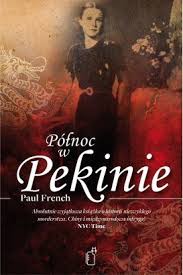
Przeł. Stanisław Tekieli
1937 rok. Kolonialny Pekin. Pewnego dnia córka brytyjskiego konsula nie wraca do domu…
Szokujące morderstwo wstrząsnęło Chinami u progu II wojny światowej. Ciało Pameli Werner znaleziono blisko Lisiej Wieży, poza Dzielnicą Poselstw, w miejscu, które, jak mówią legendy, jest nawiedzane przez duchy zwierząt. Dla chińskiej policji martwa biała dziewczyna oznacza kłopoty, zwłaszcza że stan ofiary wskazuje na czyn brutalnego maniaka. Całe miasto huczy od plotek i podejrzeń. Ku rozpaczy ojca Pameli, śledztwo okazuje się trudniejsze, niż ktokolwiek mógł się spodziewać. Czy uda się je doprowadzić do końca, zanim Japończycy rozpoczną inwazję?
Paul French, historyk i znawca Chin, po wieloletnich badaniach ujawnia, co naprawdę wydarzyło się przed laty.
Książka została wyróżniona prestiżową Nagrodą Brytyjskiego Stowarzyszenia Autorów Powieści Kryminalnych i nagrodą Edgara Allana Poe w kategorii Best Fact Crime.
Posted: July 22nd, 2014 | No Comments »
Mark O’Neill’s From the Tsar’s Railway to the Red Army is now available as part of the Penguin China World War One e-book series…Following his book on the Chinese “Coolie Corps” who worked on Europe’s WW1 battlefields, this short book follows those Chinese who worked in Russia and found themselves caught up in the Bolshevik Revolution…

It is a little known fact that during the First World War Russia received the majority of Chinese wartime labourers working overseas. Despite assurances that they would not be involved in the war, thousands of Chinese workers dug trenches and carried ammunition for troops on the Eastern Front under brutal conditions. Then, in 1917, life for the Chinese worsened with the Bolshevik Revolution’s arrival. Some of the workers signed up to fight for the Red Army and many were left stranded in Russia, unemployed and destitute. Their plight has been described as the most tragic episode in 400 years of Chinese emigration. The men had crossed the border into Russia with dreams of earning enough money to build a house or business for their family at home. None could have imagined the hell that awaited them.
Posted: July 21st, 2014 | No Comments »
This year is of course the 110th anniversary of the Russo-Japanese War. Just as before with the Boxer Rebellion, the Russo-Japanese War inspired a raft of novels based on the war, the fear of invasion from the east (the Yellow Peril) and general concerns following the defeat of a European power by an Asian one.
Emile Driant (below) produced one of the best sellers in this quick fire post-war genre, L’invasion Jaune (The Yellow Invasion), published under the pseudonym Capitaine Danri. Driant was a French army officer and novelist of a decidedly nationalistic bent. The Yellow Invasion was published in 1905. The story depicts the surprise attack against the Western world by a gigantic Sino-Japanese army, covertly equipped with American-made weapons and secretly trained in the remote Chinese hinterland (so all the enemies – Japanese, Chinese and, of course, Les Americans too). The plot is hatched by a Japanese veteran of the Russo-Japanese War coming out of the conflict with a fanatical hatred of Westerners, he organizes a world-spanning secret society named the Devouring Dragon in order to destroy Western civilization.
And there you have it….
